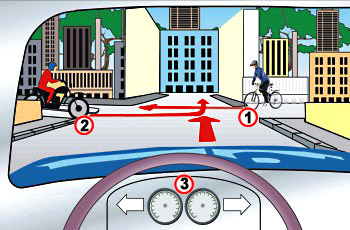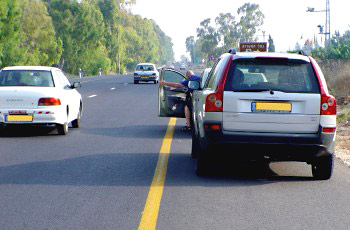Question:1
When you are driving behind a “security vehicle”, you should:
Category : Rules and Regulations
Question:2
How should one drive while inside a “play street”?
Category : Rules and Regulations
Question:3
Where is an ATV (All Terrain Vehicle) (Quad bike) allowed to drive?

Category : Rules and Regulations
Question:4
When is a driver of a motor vehicle required to dip the vehicle’s lights?
Category : Rules and Regulations
Question:5
How would you seat a child less than three years of age inside a vehicle?

Category : Rules and Regulations
Question:6
What is an “Interchange”?
Category : Rules and Regulations
Question:7
What should you do when your vehicle makes unreasonable noise?
Category : Rules and Regulations
Question:8
How do you give a signal for braking?
Category : Rules and Regulations
Question:9
A back seat passenger must wear a seatbelt. Who is held responsible if a back seat passenger doesn’t wear his seat-belt?
Category : Rules and Regulations
Question:10
You are driving vehicle no. 3 before an intersection without traffic signs. According to the rules of giving right of way, who should enter the intersection first?

Category : Rules and Regulations
Question:11
Who is responsible for a vehicle emitting smoke above statutory levels?
Category : Rules and Regulations
Question:12
During “light time”, when are you permitted to use the vehicle’s high beam?
Category : Rules and Regulations
Question:13
What is the maximum freight height (from the road’s surface) that may be carried by a commercial vehicle with an all up weight of up to 3,500kg?
Category : Rules and Regulations
Question:14
Is it permitted to take one hand off the wheel or handlebar while driving?
Category : Rules and Regulations
Question:15
When is it permitted to turn on the fog lights?
Category : Rules and Regulations
Question:16
Are passengers permitted to get in or out of the off side of a vehicle?

Category : Rules and Regulations
Question:17
What is a commercial vehicle in accordance with the Carrier Services Law?
Category : Rules and Regulations
Question:18
According to the law, in what order should vehicles enter the following intersection?

Category : Rules and Regulations
Question:19
When driving behind a slow vehicle on a roadway while a continuous centre white line is marked to your left:
Category : Rules and Regulations
Question:20
When is it permitted to drive on a pavement?
Category : Rules and Regulations
Question:21
Where should a “new driver” sign be placed?
Category : Rules and Regulations
Question:22
Under which conditions is the driver of a utility vehicle (mule) allowed to carry a passenger with him?
Category : Rules and Regulations
Question:23
When is it prohibited to stop or park a vehicle?
Category : Rules and Regulations
Question:24
Which types of vehicles must operate distress lights, or place a flashing yellow lamp, if forced to stand on a non-urban road during “light time”?
Category : Rules and Regulations
Question:25
Sudden braking is permitted when:
Category : Rules and Regulations
Question:26
When is it permitted to use floodlights?
Category : Rules and Regulations
Question:27
It is permitted to make a U-turn:
Category : Rules and Regulations
Question:28
Is it permitted to drive a heavy vehicle when the air pressure in the braking system is below the required minimum?
Category : Rules and Regulations
Question:29
For how long is it permitted to leave a broken-down vehicle on a road or in a public place?
Category : Rules and Regulations
Question:30
Who of the following is entitled to enter the intersection first?

Category : Rules and Regulations

